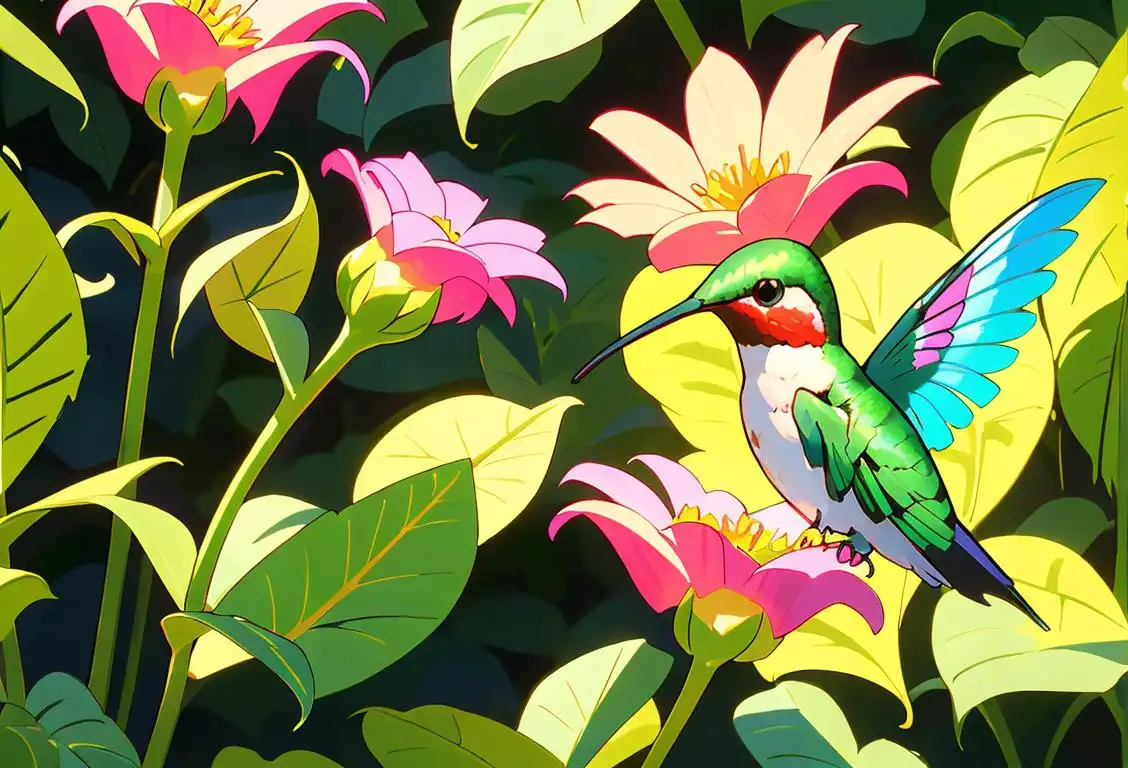National Hummingbird Day

Hey there, hummingbird enthusiasts! Get ready to flutter into the fascinating world of National Hummingbird Day. This special day celebrates those tiny, colorful birds that can fly backwards and hover like magical little helicopters in the air. Fasten your seatbelts and let's dive into the mesmerizing world of these miniature aviators!
When is Hummingbird Day?
It's national hummingbird day on the 5th September.
The Buzz About National Hummingbird Day
National Hummingbird Day is an annual celebration held on September 5th to honor these incredible creatures and raise awareness about their remarkable qualities. With their iridescent feathers and rapid wingbeats, hummingbirds capture the hearts of bird lovers all around the world.
Did you know that their wings can beat up to an astonishing 80 times per second? Yep, you read that right! These feathered friends are speedy little dynamos. Whether you have hummingbirds buzzing around your backyard or you simply appreciate their beauty, this day is for you!
A Brief History of National Hummingbird Day
The origins of National Hummingbird Day are as mysterious and agile as the birds themselves. While there isn't an exact date of when this day first took flight, it has gained popularity online in recent years, with 263 mentions detected across the internet.
Hummingbird enthusiasts and passionate birdwatchers have been sharing their love for these enchanting little creatures on social media, making a buzz every September 5th. So grab your feeders, hang up some colorful flowers, and get ready to celebrate these feathered wonders!
History behind the term 'Hummingbird'
1493
The First Encounter
In 1493, European explorers first encountered the tiny, agile bird we now know as the hummingbird. Christopher Columbus, while exploring the Caribbean, was captivated by these birds with their rapid wing movement and ability to hover in mid-air. He described them as 'birds of the sun' due to their vibrant plumage glistening like jewels in the sunlight.
1658
The Taxonomic Classification
In 1658, the hummingbird was officially classified for the first time by English physician and naturalist, Sir Thomas Browne. He named the birds 'Trochilus' after the Greek word for 'runner' or 'hummingbird,' referring to their swift flight and the sound produced by their wings. This marked a significant step in categorizing and understanding these unique avian creatures.
1804
The Origin of the English Name
In 1804, the English name 'hummingbird' was first used in reference to these remarkable creatures. It derived from the humming sound produced by their rapid wing beats, which can range from 50 to 200 beats per second depending on the species. This name perfectly captured one of their most distinctive characteristics that fascinated observers throughout history.
1831
The Discovery of the Mechanism
In 1831, French artist and physicist Jules Bourcier discovered a unique aspect of hummingbird anatomy that further intrigued scientists. He found that hummingbirds possess a flexible joint between their humerus and ulna, allowing them to rotate their wings in a figure-eight motion. This intricate wing movement is a key factor enabling hummingbirds to hover, fly backward, and change direction with exceptional agility.
1924
The Study of Feeding Adaptations
In 1924, ornithologist Alexander Skutch made significant contributions to the understanding of hummingbird feeding behavior. Through his meticulous observations, Skutch revealed the intricate relationship between hummingbirds and the flowers they feed on. He discovered that hummingbirds' long, slender bills coevolved with specific flower shapes, allowing them to access nectar deep within the blossoms.
2020
The Enthralling Symbol of Joy
Today, hummingbirds have transcended their natural history significance and become beloved symbols of joy, beauty, and resilience. They are widely appreciated for their vibrant colors, astonishing flight capabilities, and their role as crucial pollinators. Their presence inspires awe and wonder in people of all ages, making them an enduring symbol of the natural world's extraordinary wonders.
Did you know?
Did you know that hummingbirds can't walk? That's right! Unlike most birds, hummingbirds have limited walking abilities, so they prefer to use their powerful wings to zip around the skies. Who needs walking when you can fly, right?Tagged
awareness fun loved onesFirst identified
5th September 2015Most mentioned on
5th September 2020Total mentions
263Other days
Compliment Day
Cheese Pizza Day
Pumpkin Day
Medal Of Honor Day
Guac Day
Foundation Day
Suicide Prevention Day
Memorial Day
Cancer Survivors Day
Bacon Day









